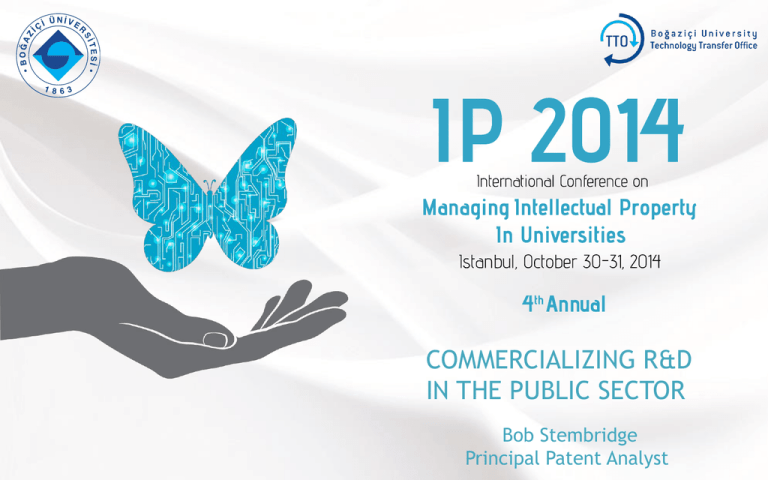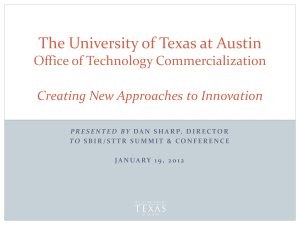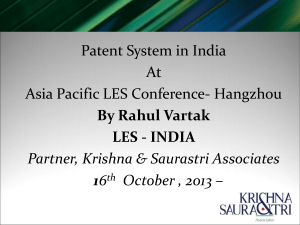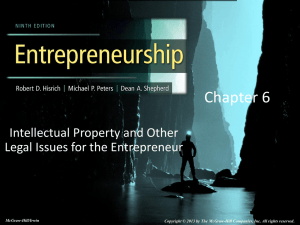Patent landscape - IP Conference 2014
advertisement

COMMERCIALIZING R&D IN THE PUBLIC SECTOR Bob Stembridge Principal Patent Analyst COMMERCIALIZING R&D IN THE PUBLIC SECTOR: PERSPECTIVES ON ACADEMICINDUSTRY TECHNOLOGY TRANSFER Bob Stembridge Prinicipal Patent Analyst Thomson Reuters IP & Science AGENDA • • • The research and innovation cycle The role of IP in commercialization Technology transfer – – – • • • Process Steps Challenges Strategies Case study Discussion WHAT DO THE FOLLOWING INNOVATIONS HAVE IN COMMON? Imaging bundles in fibre optic networks Imperial College and Technical University of Delft Gene splicing in biotech industry Stanford University and University of California Internet search engine Stanford University Significant innovations that have originated from academic research THE RESEARCH & INNOVATION CYCLE Basic Research Applied Research Wealth Innovation / Protection / Exploitation Patents THE ROLE OF PATENTS Research & Innovation Protection & Assertion COMMERCIAL RETURN ON INVESTMENT Licensing & Commercialization Application & Prosecution Maintenance & Monitoring A patent is a contract between the state and an individual whereby the state grants monopoly rights to the individual to exploit their invention in return for which the individual provides full disclosure of the invention TECHNOLOGY TRANSFER • The process of transferring laboratory findings to the marketplace through: – Licensing agreements – Joint ventures – Partnerships – Spin offs STEPS • • • • • • • Research Evaluation about the commercial potential of the invention Assessment with the researchers IP protection Marketing Licensing / Spin-off company creation Product development and commercialization by one or more licensees • Revenue generation by one or more licensees These steps may vary in sequence and often occur simultaneously SOME COMMON CHALLENGES • • • • • What does the market want? How do I attract more industry funding? Which R&D project should I invest in? How can I create more licenses and spin-offs? How can I measure the success of technology transfer more accurately? • How do I motivate my researchers to do more applied research? • How do I value my Intellectual Property (IP)? Technology Transfer is a long and risky process and requires significant time and investment THE TECHNOLOGY TRANSFER FRAMEWORK TALENT RESOURCES MARKET WORKFLOW Meeting the market need is key! IMPACT TRANSCENDING THE VALLEY OF DEATH STRATEGIES FOR SUCCESS • Frame the R&D project as a marketing challenge – Research projects are usually viewed as a scientific or technology challenge. Successful technology transfer depends on identifying and satisfying a market need • Early in the R&D Cycle: – Understand your target market’s needs – Understand and navigate the IP landscape • Throughout the R&D Cycle: – Constantly monitor the market and IP landscape and adapt your R&D strategy • Use necessary tools and databases to understand the market DECISION SUPPORT TOOLS: THOMSON INNOVATION Patent Search: Access the most relevant and comprehensive, global IP data, including the Derwent World Patents Index®, Asia-Pacific patents and Scientific Literature. Streamline your work with powerful productivity and collaboration tools. Patent Analysis: Turn large volumes of data into actionable intelligence with interactive analysis and visualization tools. DERIVING INFORMATION FROM PATENT DOCUMENTS Patent data – a valuable resource to support business decisions THE THEMESCAPE ANALYTICAL AND VISUALIZATION TOOL ThemeScape Map • Integrates data from multiple patent records in a visual form • Uncover relationships between patent documents and helps focus on related technology in a crowded space ThemeScape Map allows you to understand quickly the patent landscape and market dynamics MAPPING YOUR RESEARCH TO THE MARKET PLACE • Use ThemeScape Map to understand your target market in the following 4 ways: – Patent landscape: understand how your patents fit in the overall landscape compared to your competitors – Forward citations: use citations to understand downstream R&D Activity and search for potential licensees – Research collaborations: gain insights into who your industry partners are collaborating with and on what – Portfolio Management Tool: cluster your patents and discover new industry applications CASE STUDY 17 TURKISH UNIVERSITIES PATENT PORTFOLIO SABANCI UNIVERSITY PATENT PORTFOLIO Sabanci University has strength in Exoskeleton innovation SABANCI UNIVERSITY PATENT PORTFOLIO DETAIL PATENT LANDSCAPE FOR EXOSKELETONS Exoskeleton inventions HONDA MOTOR… UNIV CALIFORNIA ARGO MEDICAL… UNIV TSUKUBA BERKELEY BIONICS COMMISSARIAT… UNIV DELAWARE TOYOTA MOTOR… RAYTHEON CO 0 20 40 60 EXOSKELETONS - COMPETITIVE LANDSCAPE FORWARD CITATIONS HELP IDENTIFY DOWNSTREAM R&D ACTIVITY AND POTENTIAL LICENSEES • Impact via Citation: – Self-Citations claim priority or measure follow-on R&D – Cites from external sources measure competitive interest – Cites from examiners may reflect closeness of the art Forward citations provide an indication of downstream R&D activity by industry players and how the market has adopted your research EXAMPLE OF A UNIVERSITY PATENT FORWARD CITATION First level citations Second level citations Third level citations Use citation maps to identify different citers and their downstream activities FIRST AND SECOND GENERATION FORWARD CITATIONS ThemeScape Map can be used to cluster forward citations to understand downstream R&D Activities RESEARCH COLLABORATIONS: COMPETITIVE INSIGHTS INTO INDUSTRY PARTNERS’ COLLABORATION ACTIVITIES • Research collaborations with private corporations are important engagement points for Universities: √ √ √ √ √ IP Commercialization (for Pre- and Post-Collaboration IP) Learning from the Corporation Branding Industry Revenue Economic Benefit COMPETITIVE INSIGHTS INTO INDUSTRY PARTNERS’ COLLABORATION ACTIVITIES • Engaging Industry Partners √ √ √ √ Publish Strategically Develop Key Account Managers Study Your Industry Partner’s Roadmaps Understanding who and what your Target Industry Partners are working 27 CONCLUSIONS • Commercialization is a long and risky process and requires significant investments in talent, resources and workflow processes • A key to crossing the “Valley of Death” to successful commercialization is understanding the market needs and competitive landscape • Thomson Innovation and the ThemeScape Map are useful tools to understand the market dynamics and patent landscape • There are four different techniques available. This allows R&D to be more “structured” and enhances commercialization opportunities








